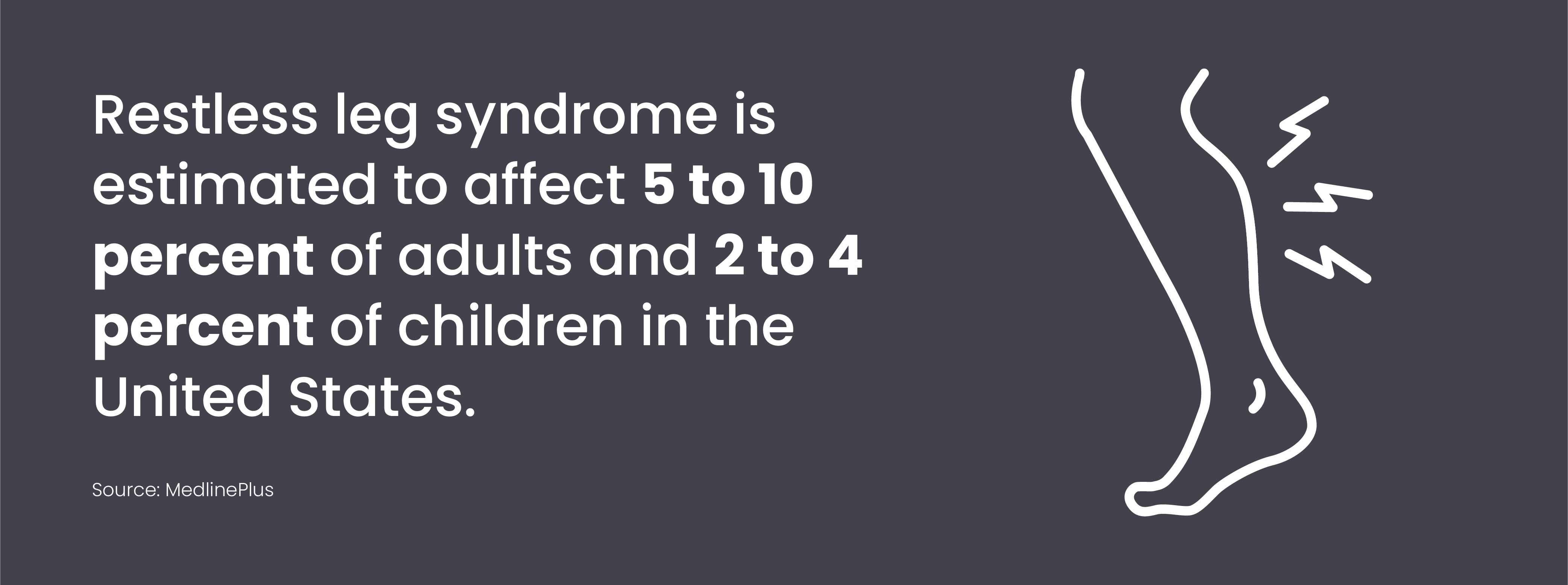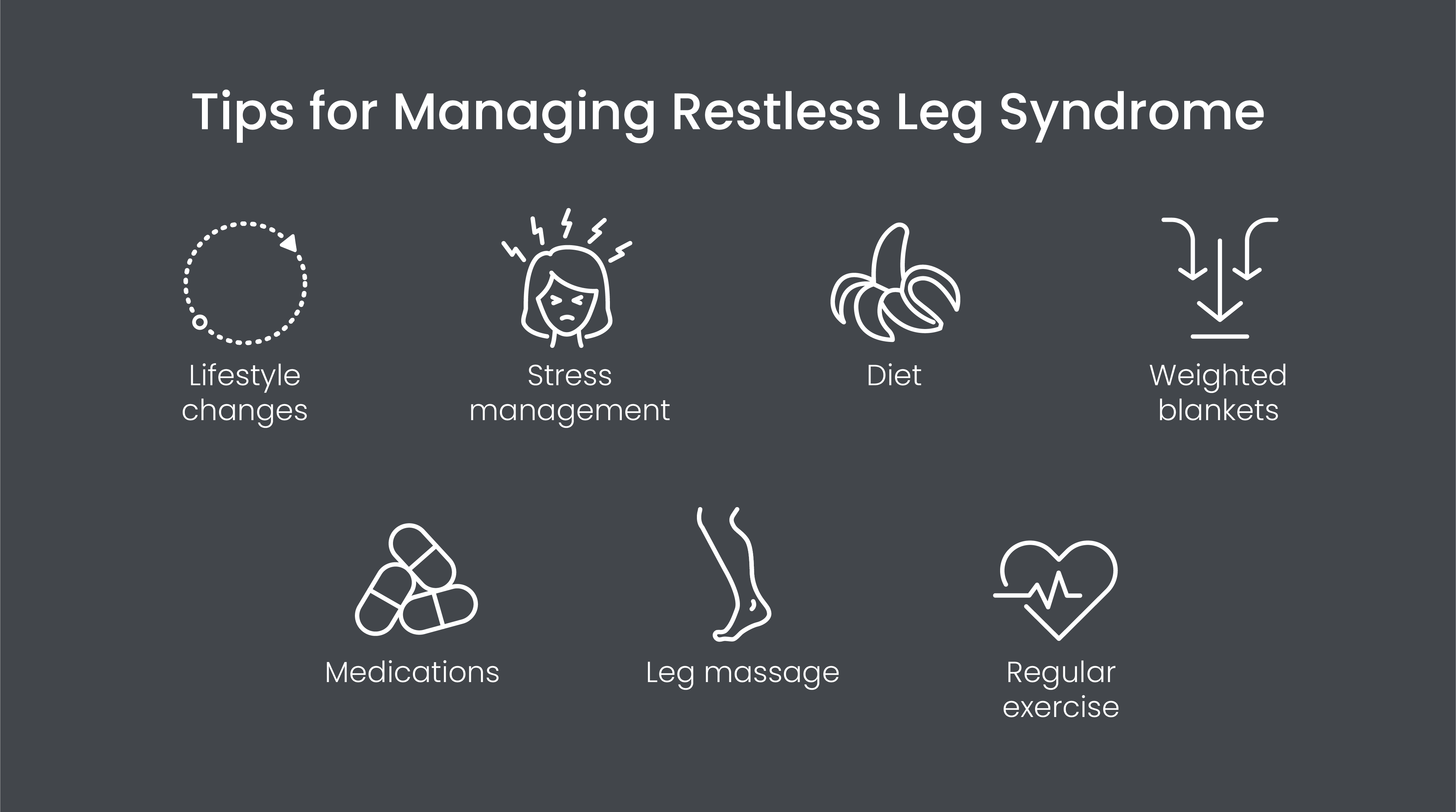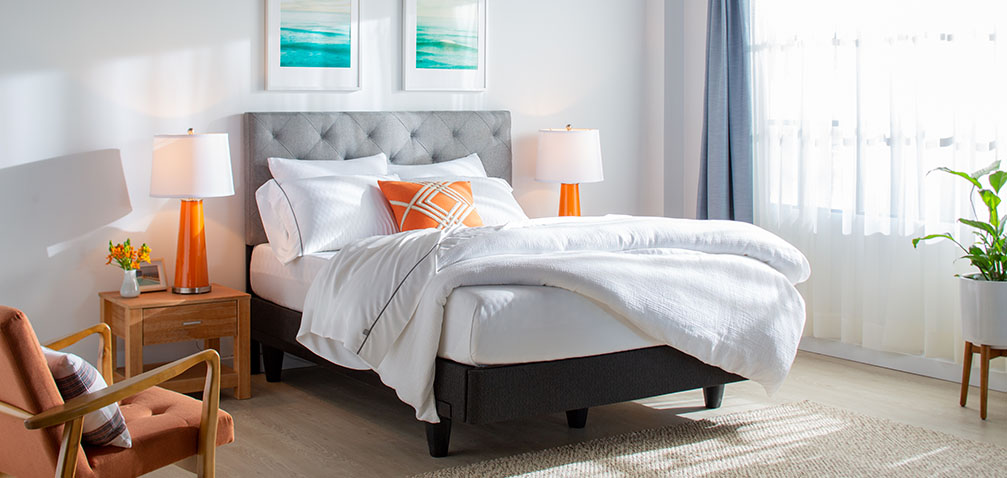As a result, countless individuals find themselves tossing and turning, searching for relief. In this article, we’ll discuss the underlying causes of restless leg syndrome, its impact on sleep quality, and potential treatments to help those with restless legs get a peaceful night’s sleep.
- What Is Restless Leg Syndrome?
- What Causes Restless Leg Syndrome?
- Why Do Restless Legs Keep You Up at Night?
- How Can You Manage Restless Leg Syndrome?
- Sleep Hygiene Tips for Those With Restless Leg Syndrome
- Key Takeaways: Why Restless Legs Are Keeping You Up at Night
What Is Restless Leg Syndrome?
Restless leg syndrome, also known as Willis-Ekbom disease, is a neurological disorder that manifests as an irresistible urge to move the legs. This feeling is often accompanied by uncomfortable sensations like crawling, pulling, throbbing, and tingling, typically occurring deep within the legs. While sensations can sometimes involve the arms, the legs are predominantly affected. It’s a condition with a significant impact: 5 to 10 percent of adults and 2 to 4 percent of children in the U.S. are affected by restless leg syndrome.

According to the National Institute of Neurological Disorders and Stroke (NINDS), RLS symptoms typically worsen during the evening or night hours and can vary in severity and duration from person to person. The sleep disturbances caused by these sensations can severely impact an individual’s ability to sleep, leading to fatigue and decreased quality of life.
The complexity of RLS means that a comprehensive approach to diagnosis and treatment is essential. While there’s currently no cure, several strategies, medications, and lifestyle changes can help manage the symptoms and relieve those affected.
What Causes Restless Leg Syndrome?
Restless leg syndrome is a mysterious condition with roots in genetic and environmental factors. Those with RLS often find themselves wondering why they have a compelling urge to move their legs. While the exact cause of RLS isn’t fully understood, a variety of factors have been identified that might increase someone’s risk or exacerbate existing symptoms, including:
- Stress: Emotional stress can trigger RLS. Many people report that their symptoms worsen during periods of increased stress or anxiety.
- Genetics: RLS has a hereditary component. Individuals with a family history of RLS are more likely to develop this condition, suggesting certain genetic markers could be linked to its onset.
- Lifestyle factors: Excessive consumption of caffeine, alcohol, or tobacco might exacerbate RLS symptoms in some individuals. A lack of regular physical activity may also contribute to the severity of restless legs.
- Medications: Some drugs, including antipsychotics, antidepressants, and cold medications containing antihistamines can aggravate symptoms.
- Iron deficiency: A notable link exists between iron deficiency or anemia and restless leg syndrome. Lower iron levels in the brain might contribute to more severe symptoms.
- Dopamine imbalance: Dopamine is a neurotransmitter that plays a key role in controlling muscle movement. Disruption or imbalance in dopamine may be a contributing factor to RLS.
- Pregnancy: Many pregnant women experience restless leg syndrome, especially during the third trimester. However, their symptoms typically diminish or disappear entirely after delivery.
- Chronic health conditions: Chronic diseases and conditions like renal failure, diabetes, and peripheral neuropathy have been associated with RLS.
Why Do Restless Legs Keep You Up at Night?
Remember, RLS leads to an insatiable urge to move the legs, primarily during periods of rest or inactivity. This discomfort intensifies at night because you’re at rest. Let’s take a look at a few of the ways restless legs keep you up at night:
- Urge to move: The hallmark symptom of RLS is a relentless urge to move the legs. This feeling can be so overpowering that staying still feels impossible. The resulting need to adjust your position or walk around can make settling into sleep difficult.
- Difficulty falling asleep: The sensations experienced due to RLS most commonly arise during relaxation, making the act of falling asleep a battle. As the mind starts drifting toward sleep, the tingling or crawling sensations in the legs can jolt you awake.
- Unpleasant sensations: Described as crawling, itching, pulling, or throbbing sensations within the legs, these sensations can be outright painful for some. The distress caused by such sensations can create a heightened sense of alertness.
- Sleep fragmentation: Even if individuals with RLS manage to fall asleep, the recurring sensations can lead to multiple awakenings throughout the night. This interrupted sleep pattern prevents you from enjoying long, uninterrupted deep sleep.
- Decreased sleep quality: As a result of all the above factors, the overall quality of sleep for those with restless leg syndrome is compromised. Even if they spend several hours in bed, the actual deep sleep they get might be minimal, leading to feelings of fatigue the next day.
How Can You Manage Restless Leg Syndrome?
Despite the challenges that come with restless leg syndrome, there are several avenues that may provide some relief. Tackling RLS often involves a combination of medical interventions and lifestyle changes tailored to the individual’s unique needs. Here’s a closer look at a few options for restless leg syndrome treatment.

- Lifestyle changes: Simple modifications to your daily routine can make a significant difference. Given the relationship between caffeine and sleep, individuals with RLS should monitor their caffeine consumption, especially closer to bedtime, to prevent potential exacerbation of symptoms. Establishing a consistent sleep schedule and creating a comfortable sleeping environment can also be beneficial.
- Stress management: As stress can trigger or worsen RLS symptoms, adopting stress-management techniques like meditation, deep breathing exercises, and yoga can be helpful in reducing symptoms.
- Diet: Iron-rich foods can be beneficial for those with an iron deficiency. It’s also advised to limit your intake of refined sugars and stimulants. Consulting with a nutritionist can also provide personalized dietary recommendations.
- Weighted blankets: Some people with RLS find relief using weighted blankets, which apply gentle pressure to the legs, potentially reducing the urge to move. The weighted blanket benefits are numerous, ranging from deep touch pressure that calms the nervous system to potentially decreasing the restless sensations RLS sufferers experience.
- Medications: Several medications, including iron supplements and dopaminergic agents, can alleviate RLS symptoms. These drugs, originally developed for Parkinson’s disease, can increase dopamine levels in the brain to reduce RLS symptoms. As always, seek professional medical advice before starting any medications.
- Leg massage: Massaging the legs can provide immediate relief from the uncomfortable sensations associated with RLS. Incorporating warm oils or lotions can enhance the soothing effect.
- Regular exercise: Engaging in moderate, regular exercise has been shown to reduce the severity of RLS symptoms. However, it’s important not to overdo it or exercise too close to bedtime, which can have the opposite effect.
Sleep Hygiene Tips for Those With Restless Leg Syndrome
Sleep hygiene refers to the habits and practices conducive to sleeping well on a regular basis. By incorporating good sleep hygiene practices, those with RLS can better manage their symptoms and set the stage for a more restorative night. Here are a few sleep hygiene tips that may be able to reduce your RLS symptoms:
- Use an adjustable bed: Traditional beds may not provide the optimal comfort level for those with RLS. An adjustable bed allows individuals to elevate their legs or adjust their sleeping position, which can help alleviate some of the uncomfortable sensations associated with RLS. Elevating the legs might also promote better circulation, further reducing the urge to move.
- Form a consistent sleep schedule: Routine can be powerful in helping manage RLS symptoms. Going to bed and waking up at the same time every day, even on weekends, helps regulate the body’s internal clock and can improve sleep quality over time. Consistency reinforces the sleep-wake cycle, potentially making it easier to fall asleep and stay asleep despite restless leg syndrome symptoms.
- Create a sleep-conducive environment: Your surroundings while you sleep can significantly impact the ability to rest, especially for someone with RLS. Keeping your room cool can help promote better sleep while using blackout curtains, and keeping the lights off can signal the brain to release melatonin, a hormone that promotes sleep. You should also invest in comfortable bedding and pillows to improve your comfort and reduce the need for frequent adjustments throughout the night. Additionally, consider creating calming playlists for sleep. Music or soundscapes can effectively soothe restless minds and legs, aiding in drifting into a peaceful slumber.
Key Takeaways: Why Restless Legs Are Keeping You Up at Night
Managing restless leg syndrome requires a multifaceted approach. Lifestyle changes, from dietary modifications to stress management, play a significant role. Additionally, sleep hygiene is instrumental in mitigating sleep disruptions caused by RLS.
When it comes to optimizing the sleep environment, the mattress plays a pivotal role. Layla Sleep offers high-quality mattresses designed to cater to the varied needs of sleepers. For those grappling with RLS, a comfortable, supportive memory foam mattress can potentially minimize the discomfort and disturbance, allowing for a deeper, more restful sleep. Alternatively, our hybrid mattress combines the resilience of springs with the comfort of memory foam, offering both support and adaptability – a combination that might be perfect for those with RLS. We prioritize comfort, support, and durability to ensure that even those with challenges like RLS can find sanctuary when they rest their heads for the night. Shop our collection of sleep products today.



